Copyright ©2001 by Dennis Báthory-Kitsz
Eric Lyon is infuriating. I think he knows it, and enjoys it.
He asked: "I'm interested in having you talk about being an independent computer musician. How you deal with hardware, software, digital music distribution, and what it's like being 'out there'."
Easy one. At first. Then I went through the stages -- denial, anger, resignation.
What sort of question is that? Independent computer musician? That sounds like a lame Star Trek joke.
I'm a composer. I use a computer. Who doesn't?
To me, it seemed a natural evolutionary course in the past quarter-century. To you, it may seem unworthy of discussion -- the computer has been a bête familiale for your entire lives. It is unlikely you've ever met a musician who wasn't a computer musician, whether it's a college studio composer or a garage-band guitarist with a rack of special effects.
So let me enumerate how I think an independent composer uses a computer. The emphasis is on independent because in academia or within the commercial music establishment, much of the service is provided by others, including students.
Computer as hammer began in the iron days of the 1970s and early 1980s. If a computer was needed to function in some musical role, customized hardware was built and low-level software was written. The independent computer composer kept a bench of soldering irons, wire-wrap tools, transistors, integrated circuits, machine-language manuals, and monitor/editing software.
Computer as servant dates from the digital sound-aware days of the mid-1980s -- the Mac and MIDI era, the stand-alone synth era, when composers turned away from hand-built equipment, but not away from brain-(break)(ach)ing programming. Embedded computer control was born.
Computer as assistant begins with the application era, where general-purpose sound, notation, and manipulation software combined with a plethora of relatively inexpensive audio hardware. It also corresponds with the rise of PCs as the default platform for many independent composers.
Computer as producer is a post-hardware concept, that is, the herald of the appliance era. The computer becomes tertiary -- a boxed product secondary to the meta-application that coordinates the suites of software services that are themselves secondary to industry-standard processes of recording, effects, mixing, and mastering.
Computer as inspiration is one of the most interesting, and actually predates all of these other aspects, and lives on through them.
What is built with one's own hammer is original, personal, and cherished.


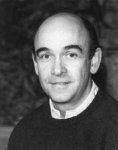
Behrmann, Spiegel, and Dodge
Early inspirations were David Behrmann, Laurie Spiegel, and Charles Dodge (who teaches here at Dartmouth). Behrmann created interactive pieces with a microcomputer. Spiegel's software alone created sound output, and some of it is coursing away from the solar system on the Voyager spacecraft. Dodge extracted magnetic field charts and devised software that played the patterns and textures.
With the possibility of electronic assessment and digital replication of events, I began inventing compositions. Network C/R, created -- or rather scored in 1975 -- a performance with tethered dancer and interactive electronics, using the dancer's body to control the music via a web of sensors. Three versions were written and the hardware and costumes designed, but none was ever realized, largely because of the cost.
Ultimately, it was Behrmann's hammer that I recall best. In 1977, I encountered his Figure in a Clearing in person. It was performed with a cello and a single-board, 1,024-byte memory KIM-1 microcomputer, outfitted with sensors and wave generators. I coveted this ability to modify output from input in a predictable and self-standing way, and promptly exhausted my life savings to buy a computer, learn to program, and start building hardware -- casting my own hammers.


"The Custom TRS-80" and "Learning the 6809"
In the mid-1980s, I was still building hammers with my own small computer company. I created the interactive Nighthawk in 1984, using several Tandy Color Computers to form a virtual cube. Visitors could cause the system to react in various sonic ways, including my first experiments in "negative" reaction, or silencing, like electronic insects. The Color Computers were ideal for an independent computer composer -- inexpensive at $200, and easy to interface with a set of published schematics and specifications, and using non-proprietary parts.
In 1986, sculptor Fernanda D'Agostino and I created a new "culture" called In Bocca al Lupo. This was an artificial culture invented by sculptor D'Agostino and for which I developed an artificial lexicon of sound and sonic ritual and language.
Infrared output and sensor arrays were connected to a set of five computers with data-gathering boards, sound-generating software, and hardware controllers (for tape loops), managed by a critical algorithm with an ability to learn the use of the space.
Multiple speakers were embedded in walls and sculptures. Visitors' movement through the space was detected by sensors, and the computers determined their location, direction of movement, and motion quality. The immediate data was compared with recent and historical data on the room's use.
Warning-like sounds grew louder or changed character; steadier sounds quieted as insects or frogs might do when disturbed; other sounds moved away from approaching visitors so they always appeared to sound from the distance. These electronic sounds were mixed with prerecorded chantlike or percussionlike natural and electronic sounds (on the tape loops) to provide a constant aural nest and cultural immersion.

Control for In Bocca al Lupo
During the five-week installation, the computer system learned how the space was used. Rarely visited areas (such as corners) became more aggressive in their (re)actions, frequently used areas (such as the single entry door) became uninterested in nearby motion and made little change.
Battery-backup memory chips and hardware real-time clocks kept the changes alive and the learning ongoing during the exhibition, even during the night, so the system knew when to get quiet or constant. But in the 15 years since Bocca has been dismantled, the embedded batteries have died in the chips, and so the Bocca history has been erased from memory. A fitting cultural end.
Bocca was rudimentary 'intelligence' -- little more than building a tiny, intertwined database (almost too small to call it that) and having the program modify itself (a Bad Thing in computerdom) not because it was truly intelligent, but because there wasn't enough memory or processor speed to save and search huge arrays of information.
The digital sounds in Bocca were all produced by a program I wrote called Quaver, which produced four independent voices per processor, which was marketed by my company.
Bocca received only passing attention in the days when personal computers were not high on the public's (or art publishers') horizon. Some of these ideas are being reworked today with more powerful machines than 0.9 MHz computers hooked together with homemade hardware. I wrote all the software in assembler, and burned it into EPROMs, as those were the days when disk drives were expensive and unreliable for running mission-critical applications like an installation; there were no electronic curators in 1986 -- when I flew back to Vermont, it just plain had to keep working for 40 days!
(A similar outdoor installation, Travelers Rest in 1991, was vandalized. I wrote a performance piece for it, since the interactive space was ruined. Documentation of Wolf5 is at http://maltedmedia.com/people/bathory/wolf5/)
The application era changed my role as a computer musician. Teams of programmers could produce general-purpose sound, notation, and manipulation software faster than a single composer could create them, and audio hardware dropped below the cost of a single analog-to-digital computer chip.
But simultaneously and sadly, a new chasm appeared between the academically or studio-associated composers and the independents, as Macintosh computers were provided, in a marketing coup, at low cost to schools and students. On the other hand, prices started a steep (and continuing) descent on business-class machines -- IBM PC-compatibles.
A choice of different processor families and architectures, not to mention a difference in marketing philosophy, widened the chasm. On one side were the wealthy and influential early adopters, including film companies, sound studios, and universities. Academically supported software for experimental music was written for the expensive iron; business-class machines were shunned.
Today this may seem insignificant, but for the impecunious independent computer composer in the later 1980s, it was debilitating and occasionally humiliating. A language such as the excellent Phil Burk-Larry Polansky collaboration HMSL was (and remains) unavailable for the PC. Composers such as Joel Chadabe declared the Windows platform entirely unsuitable for musical creation. The IRCAM enfant terrible, the Max programming environment, was kept away from PCs. Competitions and conferences rejected non-Apple formats, and CD producers refused accompanying materials created on Windows PCs; some still do.
The intervening years have revealed the platforms to be equally capable, but for more nearly a decade, the deed was done. Electronic composition became a serious and disturbing class issue, the cause of no little bitterness for composers like me.
(Ultimately, that is a diversion from the idea of computer as amanuensis, but an important part in the history of the computer composers and how the most visible among them veered dangerously away from a popular audience.)
Once the economic viability of the PC platform was discovered, assistive software became available -- scoring programs like Finale, sequencers like Cakewalk, sound editors like Cool Edit, manipulation tools like Audiomulch, and production suites like Sonar. Independent composers were no longer looking enviously in the window.
The computer assistant was welcome. In 1991, I spent a month in Cologne, but I never saw the city. My family did ... while I stayed in the kitchen, copying notes of an orchestral score for rehearsal. Having missed the glorious old town, I resolved never to spend another day with pen in hand, and obtained software for scoring.
But that was merely an extension of existing tasks. The real excitement for a computer composer was having a body of tools that analog forms could only approximate. Some, such as replacing the razor blade with the non-destructive, 'undoable' digital splice, were welcome enough to restore and 'clean up' earlier, imprecise versions, much as Frank Zappa did when the Synclavier and digital editing became available to him.
Other opportunities were more significant. The manipulation of sound waves in time and pitch, the reanalysis through transformation, and indeed the transformation of non-sound objects into sound ones, were facilitated by the computer. In 1970, I spent days making the hundreds of splices, making the re-recordings and overdubs, adding the cobbled-together special effects, to create my Electronic Construction. Today -- assuming I had the inspiration and initiative -- it would be an afternoon's relaxation.
Interestingly, reducing drudgery opened the doors to experimentation and improvisation, offering the ability to inspire.
The computer as inspiration is of great interest to me. The question always arises: "Where do you get your notes?" In the electroacoustic genres, 'notes' is not the right term, but the question of wherefrom-comes-yon-inspiration is valid.
Here's what I mean -- though this may seem obvious from the perspective of this century:
When caught up in the production process -- inking and copying or cutting and splicing -- a great deal of mental energy is depleted in meeting the standards of precision required. It is the rare independent composer today who has copyists or workshops, so the enervation of creating scores, parts, and tapes from raw materials is distracting and mentally wasteful. As our own driven and underpaid employees, we become exhausted with the exactitude of the preparation, and push away the mental intrusion of inspiration and imagination. It's not a universal result, but it's a familiar one among composers.
However, the removal of these menial duties does not merely cast the computer into the role as our slave; instead, because it is possible to explore possibilities both non-destructively and playfully, we can visit again at the court of improvisation. This is a different kingdom from that of Charles Dodge's inspired Earth's Magnetic Field, where thousands of punch cards had to be exactingly prepared for the sound to arise, bidden from the electrons.
Instead, it's possible to set automated processes to going forward -- not unlike but then again very unlike the processes of the minimalists. It is auditionable, it is selectable, and significantly, it is dismissable. Like Charlie Parker's solos, each one can be heard as an on-the-feet composition, or a practice session, or a jam between composer and compadre -- except that it's also replicable. And once what's been done is replicable, it becomes malleable through analysis. It, in effect, stills the process of sound, freezes the improvisation, and lays it naked on the screen.
Okay, whoa, maybe poetry damages this thought. In practical terms, a composer can invent a process, or simply distill it from existing music -- "how did Mozart do it?" Then the process of Mozarting can be set in motion (it might have been called development in 'dot music' terms). The Mozarting can be done again and again, tweaking the parameters until it's Haydning or Brahmsing or Stockhausening, stashing the results.
Within the dot-music world, Clarence Barlow's Autobusk sets parameters for rhythmic, harmonic, and melodic content so that a single sonic idea can be mutated into a classical composition or an avant-garde romp. Peter Beyls's Oscar accompanies what he plays in a very postmodern way, while Henning Berg's Tango has a jazz expressiveness built in. All three are a kind of jam session, but Jeff Harrington and Nick Didkovsky use the electronic options to create possibilities which they examine and dismiss.
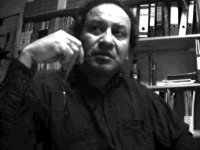

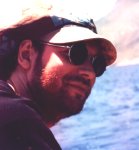


Barlow, Beyls, Berg, Harrington, Didkovsky
Within the electroacoustic realm, the possibilities are not easily imagined because the precedent is so recent, without the centuries of exploration that has refined (and limited) the dot-music choices. Experimentation is not merely an opportunity, it is more than an obligation -- it is an inevitability.
(It also returns to the days of the analog synthesizer, the god among machines. The god among machines was a trickster, permitting a laissez-faire randomness, but at the price of replicability. It was a wellspring of raw ideas. But more on that in another talk.)

Killer
One of the joys of (for example) abusing analog synths, sending Audiomulch into a frenzy, dropping the silverware, cross-wiring hardware, or changing geography is the ability to release control and expand my choices. Perhaps it takes genius that I don't have to be clear from concept to realization. The devil in me certainly likes to pollute the mathematical pool whenever possible. It seems I can hear an algorithm beginning its flow downstream from quite a distance, and I dump a bucket of fish (or worse) into it. I believe in approximation. That might also explain why I'm especially fond of involving performers or slippery elements in my electroacoustic compositions.
I must admit that unfettered experimentation can be interpreted as the refuge of the incompetent -- "so you can't do the math." I can. But I don't. I won't. I hate it. It's not useful path for me. There are already enough choices that I've found my own contributions unhelpful to my work. Not to mention that I spent the better part of a decade creating byte-by-byte code before I realized others were creating much better hammers for me to use to shape sound. I found myself bound up in the process of creating the tools, and those misspent hours kept me from the process of creating the art. Others can do both, but I'm not one of them. And there's also my distaste for music where it says "algorithm" ("Here comes another one", as Monty Python might sing) before it says "beauty" (fill in your own artistic goal).
Epiphanies I have had as an experimental computer composer. I was hard at work on an orchestral piece propelled by Markov analysis and then acoustically modeled. 20 minutes into the full score, I threw it up because it was marvelous but empty. Yes, so I took what I'd learned into subsequent compositions and only then created ones that I actually wanted to hear. Those moments of refusal are actually the beginning of a voyage of discovery.
(It is, of course, a painful irony for me when my works which have no conscious mathematical or algorithmic basis get heard as having one. But that's another story.)
Beethoven may have been inspired by sound of the brook or the thunderstorm, but the computer composer is inspired by possibilities outside natural manifestations and within a non-framework of all-things-possible-even-if-unheard.
(Again, to divert, some computer composers have flown from sound and especially from listener to a cloister of concept, where the argument of cause-effect, narrative, or pure presence obtains a higher perspective than the resulting sound. From the mouth of a composer-philosopher genius like John Cage, it is wise. From others, I fear, it is lame obfuscation. I hope it will pass.)
Yes, it is an inevitability because the language -- this term is itself disputed by many in the electroacoustic/computer music realm -- of creation and reception, of composition and listening, is rudimentary and often opaque. (And curiously, it has once again split along lines of empowerment, and separately identified the 'computer composers' of garage bands vs. those in the universities.) (So many diversions, so little time.)
The flight from audience and sometimes sound itself underscores that the crisis for any composer, and in particular the independent computer composer, befalls the artist in recovering an audience. Within some scenes -- Hollywood film or Ivy League colleges -- the audience is built-in, even if small. Within other scenes -- the whole dominion that might be generically, if mis-, defined as techno -- the audience is present, if not listening any more than pop forms are generally listened to.
But where experiment remains true to its background of discovery, regardless of consequence, the independent computer composer rarely find an audience within even the circle of friends and family and neighborhood. Pop rulez, for there is no Sunday afternoon yard sale of electroacoustic experiments.
In a globe of billions, however, the diaspora of an audience can be identified, invited, and brought together electronically. This combined theatre, library, and bazaar is, of course, the Web.
Again, for you, this is hardly news. But it is not Napster or Gnutella that matter. It is the combined access to tools (an old concept pioneered by Stuart Brand) and reverse-access provided for the creations from those tools. I can find software and discover new compositional ideas. I can place my sounds in public view. I can make my dot-music scores available.
Sometimes I lose them to others, yet (though this may be a limited view in the copyright-happy environment following the 1998 Digital Millennium Copyright Act), I'm delighted to see my material in others' music. I've made the acquaintance of dozens of other composers, I've heard new work, every day dozens of visitors hear what I create, hundreds grab scores to my acoustic material every month, I've had performances and commissions exclusively attributable to my on-line presence, I earn more royalties from MP3.com than ASCAP -- and I've had no small share of welcome professional critiques of my work, criticisms that have helped me to grow (though the email that read only "your music stink" was a little sparse).
But the problems don't go away. A review of genres at MP3.com this morning shows 43 genres under 'electronic' -- including such fine divisions as illbient and happy hardcore -- but the only divisions of 'experimental' being listed as 'minimal' and 'noise'. The experimental computer composers are lumped under (you guessed it) 'classical' as 'electronic classical'.
This reveals that, despite access to tools and distribution, the computer composers have failed to make the case for the richness and diversity (not to mention the excitement) of what we do.
Recently, the manager of the station where our radio/cyber show Kalvos & Damian's New Music Bazaar is produced asked why we kept a separate library of music for our show in our home studios. We explained that it would get broken up and lost in inappropriate categories and genres at the radio station, undergoing its own kind of diaspora. He replied that it could be put together in the classical section. Imagine, if you will, how difficult it was to explain that 'classical', as he thought of it, actually encompassed as many genres and styles as all the divisions presently used as broadcast categories -- and I ticked off more than two dozen contemporary 'classical' über-genres for him.
Another experience that militates against the independent (non-academic and non-commercial) computer composer is pride. The majority of composers on a listserv to which I subscribe refuse to make their material available on line because the files would be compressed, to their acoustic detriment. Indeed, some composers whom I've heard complain bitterly on that list about being ignored do not participate in the free online streaming/download presentation sites, nor have they created their own streaming/download sites. On their personal sites, only a few electroacoustic/computer composers provide links to downloadable live/electronic performance materials, or even a convenient way to order their creations.
I agree that compression is audible and deleterious. But compressions and distortions and misrepresentations exist at every level -- whether they are limited word size (16 bits for commercial recordings), streaming compression (loss of information, such as mp3 files), compansion (FM radio broadcasting), the poor hearing that comes with age, or even play on the average classroom machine or boombox.
I promote the online distribution of music, even if it not every acoustic goal is met -- for without listeners, none of them are met, except in a personal, isolated way that ill serves the communicative nature of the sonic artform.
Composers are reluctant to be aesthetically or acoustically misrepresented as well as to be inappropriately nestled among dissimilar works. I understand those concerns even if I am not especially sympathetic to them. I have heard every possible excuse to avoid being heard in 'commonplace' venues.
To the on-line isolationist, it's a discussion of extremes. Composer Lindsay Manning wrote to me, "By your definition, eating a frozen tv dinner, prepared originally by a fabulous chef with the freshest ingredients, is just as good as eating it immediately once it's been prepared."
Yes, that's a fair analogy. But I don't say "just as good." I do say that the combination of time, money, and opportunity to sit down in the restaurant of a fabulous chef is out of reach for a great proportion of the population, including those who might very much like to expand their tastes and sample such food. If compromised replicas are their only chance to enjoy the dinner prepared as close as possible to the original, but in quantity and preserved for wide distribution, then the chef who would deny that is a selfish one, more self-concerned than outwardly concerned.
I suppose there's a political context there. To be selfish is the chef's right. It may give the chef great pleasure to live in a private, upper-class, moneyed world and create a few recipes a year, and have the chance to earn a living and critical praise by doing just that. But electroacoustic/computer composers are not as in demand as chefs are, and their ingredients and preparations are entirely alien to all but other chefs and a spare few patrons.
Many composers like it that way. The chef or composer or artist who is only patronized by the few and does not walk out into the wider world risks nothing. It is easy to say, "my work can only be appreciated properly under the conditions I set." That is safe. One can also be assured that it will not likely be a failure because first, the composer is among polite colleagues and second, the spare audience has invested in hearing the performance and it would self-reflect poorly on their choice to believe it a failure. In such circumstances, one cannot know, one cannot grow, but one can move forward confidently among one's own. Yet, conversely and confoundingly, somehow fine work shines through bad recordings and reproductions (who can fail to be astounded at Gesang der Jünglinge under its haze of tape hiss?), and can be heard or seen through the cloud of interference that I outlined in an earlier essay. Is an mp3 version a fair test? Yes, I think so. It is one view of the work, indeed a better view than most uncontrolled circumstances are going to offer you. It is the varnishing of the Michelangelo, the nasality of the Toscanini, the flickering of the Eisenstein (while even the finest production studios and their legions of artists can give us high-fidelity, high-definition Milli Vanilli, Elvis on black velvet, and Nightmare on Elm Street VII).

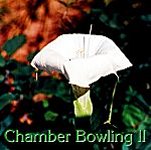


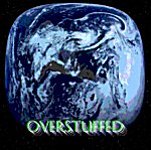


My MP3.com CDs
So Eric Lyon asked about being an independent computer musician. And there are the stages of denial, anger, and resignation. The independent computer musician ultimately does become a lame Star Trek joke, and I reiterate: I'm a composer. I use a computer. Who doesn't?
It has been the natural evolutionary course in the past quarter-century, and now every musician -- even those who tune their 17th century violins to a little box -- has been assimilated into the active use of computers, to becoming computer musicians.
Notes: Compositions using computers and the roles computers played; this does not include scoring or mixing:
Links:
| Dennis Báthory-Kitsz homepage | http://maltedmedia.com/bathory/ |
| Malted/Media Productions | http://maltedmedia.com/ |
| Kalvos & Damian's New Music Bazaar | http://kalvos.org/ |
| Trans/Media Arts Cooperative | http://transmedia-arts.com/ |
| Erzsébet the Vampire | http://bathory.org/ |
| Living Composers Project | http://composers21.com/ |